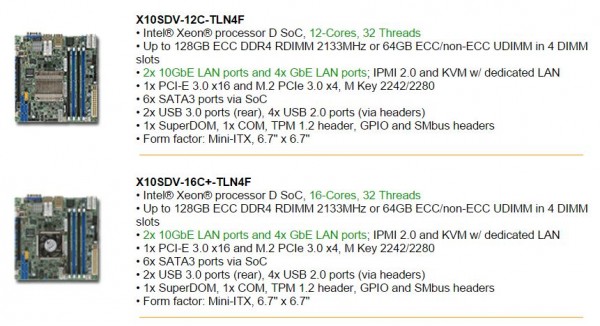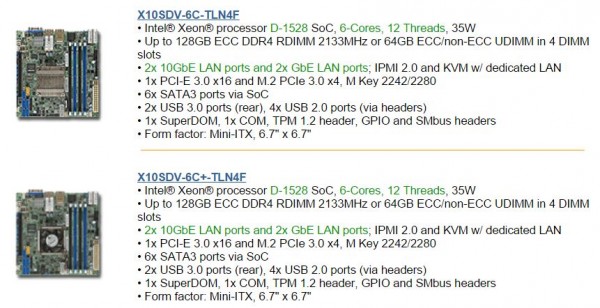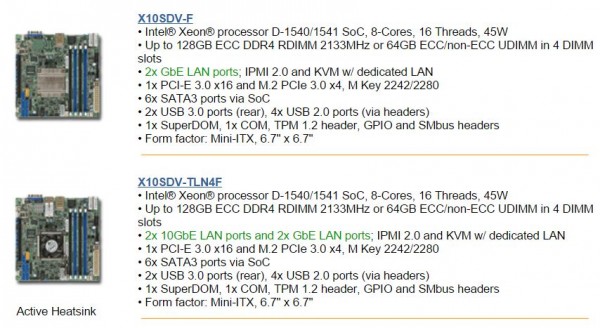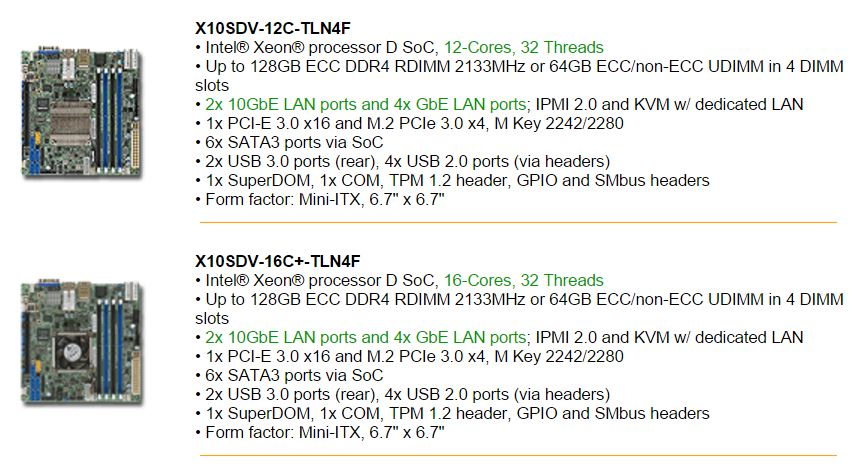With the release of new Intel Xeon D-1500 series processor, Supermicro released new motherboard designs. Interestingly two of the motherboards support 12 and 16 core Xeon D models we expect to see released in Q1 2015 per Intel’s announcement. We did reach out to Supermicro on a few points of clarification and will update as those become available.
Expanding the platform with Q1 2016 Xeon D-1500 series Processors
Although the official product release is slated for next quarter, Supermicro has details on their next-generation high-end Xeon D models. The Supermicro X10SDV-16C+-TLN4F will have 16 cores and 32 threads on the SOC while the Supermicro X10SDV-12C-TLN4F will support 12 cores and 24 threads. Both Supermicro X10SDV-12C-TLN4F and Supermicro X10SDV-16C+-TLN4F appear to support dual 10GbE ports and quad 1GbE ports. Here is a quick snap of the information we saw on Supermicro’s Xeon D page.

For those home labs using dual Xeon L56xx series processors and lower power Intel Xeon E5 V1 processors with lower expansion and memory configurations, these platforms are going to provide a very compelling use case as they will likely use less than half the power of those generations at a system level. Combine this with the plethora of LAN Ports and potentially NVMe SSDs and we are going to see some extremely strong configurations at a low power point.
Networking Accelerated Intel Xeon D-1528 and Xeon D-1518 models
During this week’s launch we saw that Intel was releasing networking optimized Xeon-D chips. Supermicro has at least three new models catering to that market. The first two are the Supermicro X10SDV-6C-TLN4F and Supermicro X10SDV-6C+-TLN4F. From what we can tell the “+” here stands for an actively cooled model while the lack of the “+” in the model name denotes a passively cooled model.

We have used both active and passively cooled Xeon D’s. For 1U chassis, the passively cooled versions are probably a best bet since they can use redundant chassis fans to cool the SoC. The Intel Xeon D-1528 onboard has a core count between the previously released D1540 (8 core) and D-1520 (4 core). The chips also come with a 35W TDP, 10W lower than the first generation 45W parts. The “8” in D-1528 denotes that it has Intel’s network acceleration technology we outlined in the link above.
The other networking accelerated Xeon D we see used by Supermicro is the Intel Xeon D-1518 in the Supermicro X10SDV-4C-TLN4F.

This has a similar Ethernet LAN port layout but is a 35W 4 core/ 8 thread design. Compared to the first generation Intel Xeon D-1520 this model has a 10W lower TDP as well as networking optimizations.
Updates to Existing Models?
We also saw a few of the models we previously reviewed including the Supermicro X10SDV-F and Supermicro X10SDV-TLN4F get slightly updated specifications.

The new spec says that they have the D-1540/1541. Previous versions of the page and as we can see in our Supermicro X10SDV-F based Xeon D review and X10SDV-TLN4F review utilized the Intel Xeon D-1540 processor. We sent a note to Supermicro asking to confirm if future motherboards will include the updated Intel Xeon D-1541 SoC instead of the Xeon D-1540. We received confirmation that the new chips will have SR-IOV enabled while the older D-1540 and D-1520 do not have official SR-IOV support.
Conclusion
We just deployed four more Intel Xeon D-1540 systems to the Fremont hosting site adding to our Proxmox VE 4.0 plus Ceph hyperconverged hosting cluster. We now know what our 2016 purchases will be. Given how low power the platforms are, we may even look at using a Microblade or Microcloud setup in our next-generation hyper-converged hosting platform.





Do any of the new Xeon D boards have SFP+ ports (yet)?